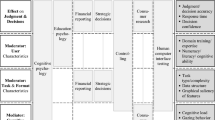Abstract
There comes a time in most group discussions that a decision has to be made. This is the role most often filled by the voting process. Through computer and telecommunication technology, new capabilities have been added to this age old process. It is important to understand the implications of these new capabilities and the voting process as a whole to fully take advantage of the opportunities and avoid the pitfalls they provide. This paper investigates the implications of voting in a group decision support system (GDSS) environ-ment. Procedural and operational issues related to the voting process are identified. These issues are used to compare and contrast a number of voting protocols. Many of the protocols have been implemented and tested in the CM3 (Computer Mediated Meeting Management) group decision support system.
Similar content being viewed by others
References
R.J. Aumann, Game theory, in: The New Palgrave Dictionary of Economics, J. Eatwell, M. Milgate and P. Newman, eds., MacMillion, London, 1987, pp. 460–482.
J. Bonner, Introduction to the Theory of Social Choice, Johns Hopkins University Press, Baltimore, 1986.
S. Brams and P. Fishburn, Approval Voting, Birkhäuser, Boston, MA, 1983.
C.H. Coombs, A Theory of Data, Wiley, New York, 1964, Chapter 18.
A. Dennis, J. Nunamaker, Jr. and D. Paranka, Supporting the search for competitive advantage, Journal of Management Information Systems 8(1991)5–36.
A. Dennis, J. Nunamaker, Jr. and D.R. Vogel, A comparison of laboratory and field research in the study of electronic meeting systems, Journal of Management Information Systems 7(1990–91) 107–135.
G. DeSanctis and R.B. Gallupe, A foundation for the study of Group Decision Support Systems, Management Science 33(1987)589–609.
D. Dufner, S.R. Hiltz, K. Johnson and R. Czech, Distributed group support: Effects of voting tools on group perceptions of media richness, Group Decision and Negotiation 4(1995)235–250.
M. Dummett, Voting Procedures, Clarendon Press, Oxford, 1984.
G.K. Easton, J.F. George, J.F. Nunamaker, Jr. and M.O. Pendergast, Using two different electronic meeting system tools for the same task: An experimental comparison, Journal of Management Information Systems 7(1990)85–100.
D.S. Felsenthal, Topics in Social Choice, Sophisticated Voting, Efficacy, and Proportional Representation, Praeger, New York, 1990.
P. Fishburn, The Theory of Social Choice, Princeton University Press, Princeton, 1973.
P. Fishburn, Paradoxes of voting, American Political Review 68(1974)537–546.
P. Fishburn, Monotonicity paradoxes in the theory of elections, Discrete Applied Mathematics 4(1982)119–134.
P. Fishburn and W. Gehrlein, Borda's rule, positional voting and Condorcet's simple majority principle, Public Choice 28(1976)79–88.
N.M. Fraser and K.W. Hipel, Conflict Analysis Models and Resolutions, North-Holland Series in System Science and Engineering, Vol. 11, North-Holland, New York, 1984.
R.B. Gallupe and G. DeSanctis, Computer-based support for group problem-finding: An experimental investigation, MIS Quarterly (1988)277–296.
B. Gavish and J.H. Gerdes, Jr., Mechanisms for maintaining anonymity in a GDSS environment, Working Paper, 1996.
B. Gavish, J. Gerdes and S. Sridhar, CM 3, Looking into the third and fourth dimensions of GDSS, in: Integration: Information and Collaboration Models, S.Y. Nof, ed., Kluwer Academic, NATO ASI Series, 1994, pp. 269–299.
B. Gavish, J. Gerdes and S. Sridhar, CM 3, A distributed Group Decision Support System, IIE Transactions (December 1995).
B. Gavish, J. Gerdes, Jr. and J. Kalvenes, Reward allocation mechanisms in anonymous GDSS, Working Paper, 1996.
B. Gavish and J. Kalvenes, Anonymous rewarding in Group Decision Support Systems and its implications, Working Paper, 1996.
J. George, J. Nunamaker, Jr. and D. Vogel, Group Decision Support Systems and their implications for designers and managers: The Arizona experience, Transactions of the 8th International Conference on Decision Support Systems, Boston, MA, June 1988, pp. 13–25.
L. Guinier, The representation of minority interests: The question of single member districts, Cardozo Law Review 14(1993)1135–1174.
T. Hare, Treatise on the Election of Representatives, Parliamentary and Municipal, Longmans Green, London, 1859.
S.R. Hiltz and M. Turoff, Structuring computer-mediated communication systems to avoid information overload, Communications of the ACM 28(1985)680–689.
P. Korhonen, H. Moskowitz, J. Wallenius and S. Zionts, An interactive approach to multiple criteria optimization with multiple decision-makers, Naval Research Logistics Quarterly 33(1986)589–602.
K.L. Kraemer and J.L. King, Computer-based systems for co-operative work and group decision making, ACM Computing Surveys 20(1988)115–146.
W.B. Ludwin, Strategic voting and the Borda method, Public Choice 33(1978)85–90.
S. Merrill, III, Making Multi-candidate Elections More Democratic, Princeton University Press, Princeton, NJ, 1988.
H. Moulin, The Strategy of Social Choice, North-Holland, Amsterdam, 1983, p. 28.
H. Moulin, Fairness and strategy in voting, in: Fair Allocation, Proceedings of Symposia in Applied Mathematics, H.P. Young, ed., American Mathematical Society, 1985, pp. 109–142.
D.C. Mueller, Public Choice II, Cambridge University Press, Cambridge, 1989.
R.B. Myerson, Game Theory, Analysis of Conflict, Harvard University Press, Cambridge, MA, 1991.
R.G. Niemi and W.H. Riker, The choice of voting systems, Scientific American 234(1976)21–27.
T. Noah, Despite loss, Perot may continue to play role in U.S. politics, Wall Street Journal, Nov. 4, 1992, p. A16 c4.
J.F. Nunamaker, Jr., A.R. Dennis, J.S. Valacich, D. Vogel and J.F. George, Electronic meeting systems to support group work, Communication of the ACM 34(1991)40–61.
M.S. Poole, M. Holmes and G. Desanctis, Conflict management in a computer-supported meeting environment, Management Science 37(1991)926–959.
A. Reeve and A. Ware, Electoral Systems; A Comparative and Theoretical Introduction, Routledge, London, 1992.
J.A. Richelson, Comparative analysis of social choice functions, Behavioral Science 20(1975) 331–337.
W. Riker, Liberalism Against Populism, Freemand and Co., San Francisco, 1982.
D. Saari, The Borda dictionary, Social Choice and Welfare 7(1990)279–317.
P.D. Straffin, Jr., Topics in the Theory of Voting, Birkhäuser, Boston, 1980.
H.P. Young, Social choice scoring functions, SIAM Journal of Applied Mathematics 28(1975) 824–838.
Rights and permissions
About this article
Cite this article
Gavish, B., Gerdes, J.H. Voting mechanisms and their implications in a GDSS environment. Annals of Operations Research 71, 41–74 (1997). https://doi.org/10.1023/A:1018931801461
Issue Date:
DOI: https://doi.org/10.1023/A:1018931801461




